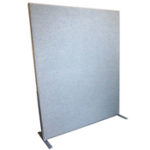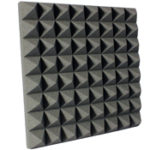
The first point of reflection is where a sound wave makes first contact with a nearby hard surface. While the sound wave will interact with numerous reflection points in any direction it travels, the first point of reflection is the one that it will meet with the most energy.
Where Is the First Point of Reflection?
The first point of reflection’s location depends on the source and its location within a room.
If you stand at the center point of a short wall on one end of a rectangular room and direct your voice toward the parallel short wall, the first point of reflection would likely be matching positions on the side walls. Moving to the left or right will shift the reflection point to the closer wall. Stepping forward will move the reflection points closer to the far wall. If the room is shorter than it is wide, the ceiling or floor could be the first point of reflection instead.
Each will have a unique first reflection point, and there will be numerous opportunities for the sound waves to interact with each other and the room’s various surfaces.
How to Find Reflection Points — The Mirror Test
The mirror test is a way to find the first point of reflection for a pair of speakers. This test requires two people and a hand mirror. One person sits or stands in the listening position — a couch or desk chair. The other holds a hand mirror against either adjacent wall at the speaker’s height. The person along the wall moves the mirror left or right until the person in the listening position can see the speaker’s reflection. Look for the left speaker when testing the left wall and the right speaker on the right wall.
Why Does the First Reflection Point Matter?
Understanding the first point of reflection matters because it can help you anticipate the relationship between a source’s position and the absorptive treatments you apply. Pinpointing and addressing the first reflection can make the remaining noise interference easier to manage.
Treating the first point of reflection will help you control some important sonic qualities:
- Clarity: Reduce echoes and reverberations that compete with the original sound.
- Accuracy: Prevent frequency cancelation from altering your perception.
- Quietness: Eliminate background noise that can interfere with a recording.
- Stereo imaging: Receive sound directly from each speaker without waves from one side returning from the other.
Ways to Treat the First Reflection Point
After determining a source’s first point of reflection, you can control those reflections using acoustic products for sound absorption or diffusion. These products cover the first point of reflection to either reduce or control the frequencies that reflect.
Shop Sound Absorption Materials
Sound Absorption
Products that have sound absorption capabilities allow them to convert airborne sound energy into heat and disperse that heat. There are a few common sound absorption materials. Foam absorbs reflections by trapping the energy inside an open-cell or closed-cell structure. Cotton and fiberglass function similarly. Some of the most effective products to place in a sound wave’s path include:
- Fabric-wrapped acoustic foam panels
- Art acoustic panels
- Free-standing acoustic partitions
- Pyramid acoustic foam
Sound Diffusion
Diffusion is the process of selective sound reflection. Sound reflects at different rates depending on its frequency, which causes inconsistent distribution throughout a room. Diffusion products feature elements like holes, protruding blocks and porous materials that optimize reflections for uniform frequency distribution to listening areas.
Control Sound Reflections With Soundproof Cow
Treating the first point of reflection is the key to a clear, immersive listening experience. Soundproof Cow can customize an acoustic treatment strategy for your listening space, so contact us online to request a free acoustic evaluation.









